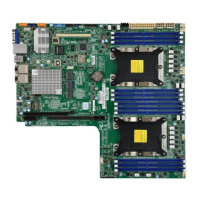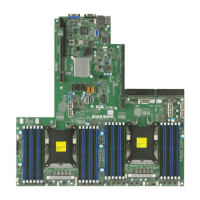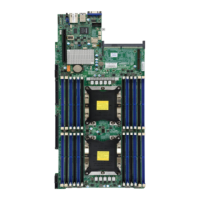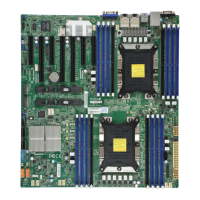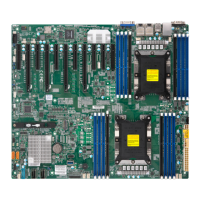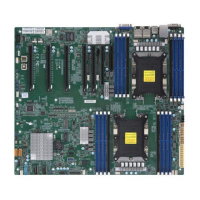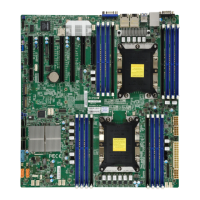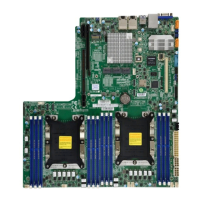
Do you have a question about the Supermicro X11DDW-L/NT and is the answer not in the manual?
| CPU Socket | LGA 3647 |
|---|---|
| Chipset | Intel C621 |
| Memory Type | DDR4 |
| SATA Ports | 8 |
| Video Ports | 1 x VGA |
| Supported Memory Types | RDIMM, LRDIMM |
| M.2 Slots | 2 |
| Ethernet | 2 x 10GBase-T |
| USB Ports (Rear) | 4 |
| USB Ports (Internal) | 2 |
| Other Ports | 1 x TPM header |
| Power Connectors | 1 x 24-pin, 2 x 8-pin |
| Memory Slots | 16 |
Provides information for the installation and use of the X11DDW-L/NT motherboard.
Describes the X11DDW-L/NT motherboard features, including processors, memory, and expansion capabilities.
Outlines the structure of the manual, detailing the content of each chapter and appendix.
Lists the main parts included with the Supermicro motherboard shipment.
Details the motherboard's support for Intel Xeon Scalable-SP processors and C621/C622 chipsets.
Describes health monitoring features supported by the onboard ASPEED AST 2500 BMC.
Covers advanced power management features, including Intel Intelligent Power Node Manager (IPNM).
Provides precautions for handling static-sensitive devices to prevent ESD damage.
Guides on installing the motherboard into the chassis, including mounting holes and standoffs.
Provides instructions and warnings for installing the CPU and heatsink module.
Details memory support, including types, speeds, and population requirements.
Identifies and describes the locations of the rear I/O ports on the motherboard.
Details the header pins (JF1) for chassis front panel buttons and indicators.
Introduces various connectors on the motherboard, starting with power connectors.
Explains how jumpers modify motherboard operations and provides pin identification.
Describes the various LED indicators on the motherboard for system status.
Identifies the PCI-E slots on the motherboard, including SXB1, SXB2, and JAOM.
Provides general procedures for troubleshooting system issues before and after power-on.
Guides users on how to contact technical support and what information to provide.
Answers common questions about memory support, BIOS updates, and power button functionality.
Details steps for removing, installing, and disposing of the onboard CMOS battery.
Explains the process for returning merchandise for warranty service and RMA authorization.
Introduces the AMIBIOS setup utility and how to access it.
Describes the main BIOS setup screen, including system date/time and component information.
Details various advanced BIOS settings, including Boot Feature, CPU Configuration, and Power Management.
Covers security settings such as Administrator Password, Password Check, and Secure Boot configuration.
Guides on configuring boot settings, including boot mode, priorities, and boot options.
Explains how to save or discard BIOS changes and exit the setup utility.
Lists BIOS beep codes and their meanings for diagnosing POST errors.
Guides on installing Microsoft Windows OS, including RAID configuration and driver loading.
Provides instructions for downloading and installing system drivers from the Supermicro website.
Introduces SuperDoctor 5 for system monitoring and management.
Explains the support for Intelligent Platform Management Interface (IPMI) for remote access.
Provides industry-standard warnings to alert users of potential bodily injury.
Warns about the danger of battery explosion if replaced incorrectly and advises proper disposal.
Explains the Unified Extensible Firmware Interface (UEFI) and its role in system boot.
Describes the process of recovering the UEFI BIOS image from a corrupted state.
Guides on recovering the main BIOS block using a USB-attached device.
Provides instructions on accessing the All Intel VMD Controllers menu for VMD support.
Guides on creating and configuring RAID volumes using VROC.
Describes the use of a journaling drive for RAID5 volumes to enhance data integrity.
Guides on selecting the boot mode (Legacy, UEFI, Dual) in BIOS setup.
Details Secure Boot, Secure Boot Mode, and CSM Support features in BIOS.
Provides step-by-step instructions for enabling secure boot features.
Covers key management settings for secure boot, including Platform Key and Key Exchange Key.
Guides on navigating to PCIe/PCI/PnP Configuration in BIOS setup for iSCSI settings.
Details iSCSI configuration settings, including initiator name, IP address, and authentication.
Guides on configuring onboard Intel LAN devices via BIOS Setup utility.
Configures the Option ROM setting for Onboard LAN1.
Enables system wake-up via the selected LAN device.

